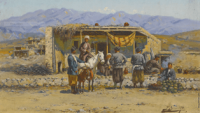You are here
Caravanserai Uchkuduk.

Excursion trips to monuments of Karakalpakstan.
“Uchkuduk - three wells.
Protect, protect us from the sun!
You are a lifeline in the desert - Uchkuduk! "
Yuri Entin.
History of Karakalpakstan.
The Uchkuduk (Ushkudyk) caravanserai is located on a natural hill 112.7 meters above sea level, in the southern part of the Ustyurt plateau, 9 kilometers southeast of the Abadan railway junction, 1.9 kilometers northeast of the road the Beineu - Kungrad road, 91 kilometers to the west and slightly south of the village of Muynak, 61.4 kilometers to the north and slightly to the west of the Kyrkkyz railway station in the Kungrad region of the Republic of Karakalpakstan.
The Ustyurt plateau is rich in monuments of the historical past. Among them you can find the sites of primitive people, ancient and medieval settlements, fortresses and caravanserais. The latter are found in considerable numbers along the caravan roads crossing Ustyurt in the southern and northern directions.
The most famous of the Ustyurt caravanserais is Beleuli, but besides him there were many other equally famous caravanserais. One of them, equal in size and importance in Beleuli's international trade, is the Uchkuduk caravanserai
The size of the Uchkuduk caravanserai approximately corresponded to the famous Beleuli caravanserai, that is, it was about 10 ares. It was also built of vertically placed 1-meter-sized shell rock slabs up to 30 cm thick.
The slabs were fastened with alabaster mortar, and the walls of the caravanserai were plastered with alabaster. The corners of the front side of the building are decorated with round towers up to two meters in diameter, and a wide entrance up to 5 meters on the sides is decorated with decorative pylons.
In the inner part of the caravanserai, many rooms of the same type and similar in size were found, grouped along the western and eastern walls of the building with a narrow corridor between them. Apparently, these were living rooms for the guests of the caravanserai, all the more so in them were found objects of living utensils and everyday life, including iron knives, fragments of bronze mirrors, stone whetstones, etc. There was also found ceramic dishes similar in appearance to the ceramic products produced in the Golden Horde cities of the Lower Volga region and Khorezm.
It is noteworthy that the copper coins that came across in the caravanserai were minted at the mints of Khorezm on behalf of the Kulpa and Nauruz khans who ruled in the Golden Horde in the middle of the XIVth century.
Most of the coins are dated to 761 AH, which corresponds to 1359 or 1360 of the now generally accepted Gregorian calendar. A distinctive feature of the Uchkuduk caravanserai was the decoration of some rooms in the form of carved terracotta tiles.
Perhaps the specially decorated rooms were something like the deluxe rooms in modern hotels. The Uchkuduk caravanserai, unlike its counterpart, Beleuli, had not one, but two vast courtyards for accommodating animals, carts, and cargo under covered sheds.
The courtyards were connected by a one-meter-wide covered walkway that ended in semicircular arches at both ends. But the most characteristic difference between Uchkuduk and Beleuli was the presence here in the central part of the courtyards of deep wells with a diameter of about 1.5 meters in the upper half.
Apparently, this gave the name to this caravanserai on the busy trade routes across the endless expanses of Ustyurt. And one can easily imagine the joy of the desert-exhausted caravan members, yearning for views and rest after a long journey, upon meeting this hospitable caravanserai with abundant supplies of drinking water and other supplies.
And they, of course, found protection from the natural and other difficulties of crossing the desert under the roof of the hotel complex of those times, which Uchkuduk served. An interesting fact is that not only medieval travelers have written records about this caravanserai.
Even in the first half and middle of the XIXth century, participants of various scientific and military expeditions who traveled here wrote about it in their diaries. And now the impressive remains of the Uchkuduk caravanserai remind people passing by about historical events that took place on the international caravan routes of our country in the distant past.
Geographic coordinates of the Uchkuduk caravanserai: N43 ° 39'30.61 "E57 ° 54'35.22"
Authority:
Musin I. "Uchkuduk - Three Wells".
http://karakalpakiya.com/ru/blog/uchkuduk-tri-kolodtsa/







